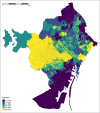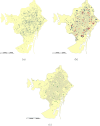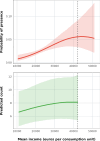Assessing and correcting neighborhood socioeconomic spatial sampling biases in citizen science mosquito data collection
- PMID: 39341898
- PMCID: PMC11439082
- DOI: 10.1038/s41598-024-73416-6
Assessing and correcting neighborhood socioeconomic spatial sampling biases in citizen science mosquito data collection
Abstract
Climatic, ecological, and socioeconomic factors are facilitating the spread of mosquito-borne diseases, heightening the importance of vector surveillance and control. Citizen science is proving to be an effective tool to track mosquito populations, but methods are needed to detect and account for small scale sampling biases in citizen science surveillance. In this article we combine two types of traditional mosquito surveillance records with data from the Mosquito Alert citizen science system to explore the ways in which the socioeconomic characteristics of urban neighborhoods result in sampling biases in citizen scientists' mosquito reports, while also shaping the spatial distribution of mosquito populations themselves. We use Barcelona, Spain, as an example, and focus on Aedes albopictus, an invasive vector species of concern worldwide. Our results suggest citizen scientists' sampling effort is focused more in Barcelona's lower and middle income census tracts than in its higher income ones, whereas Ae. albopictus populations are concentrated in the city's upper-middle income tracts. High resolution estimates of the spatial distribution of Ae. albopictus risk can be improved by controlling for citizen scientists' sampling effort, making it possible to provide better insights for efficiently targeting control efforts. Our methodology can be replicated in other cities faced with vector mosquitoes to improve public health responses to mosquito-borne diseases, which impose massive burdens on communities worldwide.
Keywords: Aedes albopictus; Citizen science; Mosquito-borne diseases; Social inequality; Vector control; Vector surveillance.
© 2024. The Author(s).
Conflict of interest statement
The authors declare no competing interests.
Figures






Similar articles
-
At the tip of an iceberg: citizen science and active surveillance collaborating to broaden the known distribution of Aedes japonicus in Spain.Parasit Vectors. 2021 Jul 26;14(1):375. doi: 10.1186/s13071-021-04874-4. Parasit Vectors. 2021. PMID: 34311767 Free PMC article.
-
Global mosquito observations dashboard (GMOD): creating a user-friendly web interface fueled by citizen science to monitor invasive and vector mosquitoes.Int J Health Geogr. 2023 Oct 28;22(1):28. doi: 10.1186/s12942-023-00350-7. Int J Health Geogr. 2023. PMID: 37898732 Free PMC article.
-
[First record of Aedes albopictus in Galicia, obtained by citizen science through Mosquito Alert].Gac Sanit. 2024;38:102374. doi: 10.1016/j.gaceta.2024.102374. Epub 2024 Mar 21. Gac Sanit. 2024. PMID: 38519323 Spanish.
-
Invasive mosquito vectors in Europe: From bioecology to surveillance and management.Acta Trop. 2023 Mar;239:106832. doi: 10.1016/j.actatropica.2023.106832. Epub 2023 Jan 12. Acta Trop. 2023. PMID: 36642256 Review.
-
A literature review of dispersal pathways of Aedes albopictus across different spatial scales: implications for vector surveillance.Parasit Vectors. 2022 Aug 27;15(1):303. doi: 10.1186/s13071-022-05413-5. Parasit Vectors. 2022. PMID: 36030291 Free PMC article. Review.
Cited by
-
Strengthening resilience to emerging vector-borne diseases in Europe: lessons learnt from countries facing endemic transmission.Lancet Reg Health Eur. 2025 Apr 4;53:101271. doi: 10.1016/j.lanepe.2025.101271. eCollection 2025 Jun. Lancet Reg Health Eur. 2025. PMID: 40247854 Free PMC article. Review.
References
-
- Allison, P. D. Discrete-time methods for the analysis of event histories. Sociological methodology13, 61–98 (1982).
-
- Barbet-Massin, M. et al. Selecting pseudo-absences for species distribution models: How, where and how many?: How to use pseudo-absences in niche modelling?. Methods in Ecology and Evolution3(2), 327–338. 10.1111/j.2041-210X.2011.00172.x (2012).
-
- Bartumeus, F., Oltra, A. & Palmer, J. R. Citizen science: a gateway for innovation in disease-carrying mosquito management?. Trends in Parasitology34(9), 727–729 (2018). - PubMed
MeSH terms
Grants and funding
LinkOut - more resources
Full Text Sources

